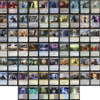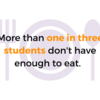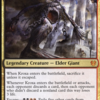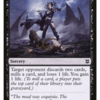Using Magic to Illustrate Food Insecurity Among College Students
January 6, 2023
As a practitioner-researcher with The Hope Center for College, Community, and Justice, one of my primary goals is to help our college and university partners build awareness of the basic needs challenges that students face. Branching out to new audiences is always a challenge, but we’ve found success in pairing robust data with compelling narratives that center students’ lived experiences. This approach lends itself well to familiar forms of outreach, like webinars, professional development workshops, and infographics, but I also like to explore alternative communication methods that could potentially resonate with untapped audiences.
Enter: Magic.

The gaming community, both digital and tabletop, are well-represented on college campuses and in their surrounding communities. By its very nature, gaming fosters communication and social interaction, making gamers a powerful conduit for word-of-mouth messaging, which continues to be among the most successful strategies for colleges in building awareness of their basic needs resources. Gamers also have a history of pulling together to support the needs of others. From my own experiences, this is particularly true of the incredible people in the Magic: The Gathering community.
Now in its thirtieth year, Magic is a card game in which players seek to defeat one another using decks built from the 20,000-plus unique cards that have been printed over the game’s history. These cards represent an array of spells, creatures, characters, and objects inspired by the history, myths, and fantasy literature of cultures all around the world.
Today, one of the most popular ways to play Magic is the Commander format. In Commander, players build decks of 100 cards using only one copy of a given card. Players must also choose a Commander, a legendary creature that represents a character from the game’s story to lead their deck into battle. Commander is designed to be played in groups of four, which helps foster a more social experience where the focus is less about any one player winning and more about everyone having a great time.
One of my favorite elements of Commander is the creativity of players when building their decks. For example, there are decks that only include cards with chairs in the artwork, cards whose names begin with the same letter, or cards that evoke the settings and characters from popular books and TV shows. Inspired by these decks, I began to think about how I might use Commander to convey the challenges faced by students experiencing food insecurity.

Around the same time that I picked up the Commander format, I also chose to return to school to pursue a master’s degree. After a bit of soul-searching, I settled on a degree in higher education administration in hopes that I could find a way to return the support I had received as an undergraduate to new generations of students, particularly those who lack the advantages I had and still have.
Upon entering the program, I found myself drawn to the issue of student food insecurity. In research terms, food insecurity is the limited or uncertain availability of nutritionally adequate and safe food, or the ability to acquire those foods in socially acceptable ways. What that means in practice is that after paying for their tuition, fees, housing, books, and other living expenses, students don’t have the money left to buy the food they need. Even with financial aid. And yes, even if they work while going to school.
Just how far-reaching is food insecurity among college students? We’re still awaiting nationally representative findings from the federal government’s first-ever collection of food insecurity data, which should be out this spring. However, thanks to my incredible colleagues here at The Hope Center as well as scholars, practitioners, and researchers from hundreds of institutions around the country, we are able to estimate that over one-third of college students experience food insecurity. Mirroring the systemic inequities that exist within and beyond higher education, this number is often far higher for students with one or more structurally minoritized identities, including Black students, LGBTQIA+ students, and parenting students.
So, we know that thousands of students can’t afford the food they need, or to do so they must make difficult choices between getting groceries and paying for things like healthcare, utilities, transportation, and course materials. As a result, these students are enduring a variety of damaging physical, cognitive, social, and psychological effects that impact not only their academic performance and persistence, but also their overall wellbeing.

In building a food insecurity-themed deck, I wanted to use cards that reflected this array of damaging effects not only in their names, but also in the impact they had within the game. To me, this meant including cards that would deny players access to the games’ main resources: cards in hand, cards in play, and life points.
Though not the only manifestation of food insecurity, hunger is perhaps the most familiar. As such, it is a foundational element represented by some of the deck’s most powerful creatures, including its Commander, Kroxa, Titan of Death’s Hunger. Name aside, Kroxa is also a great gameplay fit because he provides a consistent way to deny players cards in hand while draining their life when they run out of options.
Torgaar, Famine Incarnate is another hunger-themed creature that attacks players’ life totals. Meanwhile, the deck’s main finisher, Ulamog, the Ceaseless Hunger, removes cards directly from players’ libraries, demonstrating the sort of dwindling hope that can stem from experiencing food insecurity.

Again, food insecurity refers to sustained conditions stemming from an inability to afford food. It’s not just feeling hungry because you had a late lunch or are eating smaller portions as part of a new diet. It’s consistently skipping meals or rationing portions because you must. Now, there may be some benefits to strict portion control or the occasional fast, but when an incomplete, and often nutrient-poor, starvation diet becomes the norm, it can have serious consequences for a person’s physical health.
The deck has several cards, such as Waste Away, Crippling Fatigue, and Feebleness, that mimic these consequences by weakening or completely removing players’ creatures. None of these cards are gamebreakers, but as with the physical impacts of food insecurity, they can still have a debilitating effect on players’ plans.
As anyone who’s skipped a meal can attest, an empty stomach makes concentrating nearly impossible. Now imagine that same feeling compounding over several skipped or insufficient meals coupled with the stress of homework, exams, and bills, and it’s easy to see why students experiencing food insecurity have consistently reported difficulty staying focused in class and performing well academically.
To me, making players discard cards is an apt way to conceptualize this loss of focus within the game. As such, the deck contains an array of cards, including Distress, Mind Drain, and Mind Sludge, that force players to discard anywhere from 1-2 cards to their entire hand. Collectively, these cards help remove players’ key threats before they hit the table, disrupting their ability to succeed.

For students experiencing food insecurity, many aspects of college social life (e.g., going out for a meal or to an event with friends) can be prohibitively expensive. Whether the cost is a lot or just a little, it’s extra money these students often simply don’t have, yet not engaging can ostracize them from their peers. What’s more, this isolation can act as a form of oppression, limiting students’ ability to establish peer relationships and to build the type of social capital they will need to succeed after they graduate.
By taking away players’ cards and forcing them to make difficult choices about their increasingly limited options, cards like Ostracize and Oppression exemplify the devastating social impacts that food insecurity can have.
Similarly, I’ve included cards like Curse of Shaken Faith and Bad Deal that reflect what it can feel like to be a student in an environment not designed to support you. These cards also underscore the current public perception of the value of attending college, which stems (at least in part) from our failure to view, and fund, higher education as a public good that should be available to and attainable by everyone.
Over time, these myriad effects can have a profound psychological impact on students and their college experience. If left unaddressed, food insecurity may even cause a student to leave before completing their college credential. Painful Quandary is a card that perfectly captures the difficult choices students experiencing food insecurity must make every day as they balance the costs of their education with their basic needs.
Given the stakes of their financial decisions, many students experiencing food insecurity also punish themselves for “luxuries” like a midday snack or a cup of coffee that others often don’t give a second thought. As a result, these students may feel a sense of guilt or shame for “slipping” and making a “poor” budgetary decision.
Illustrating this thinking are cards like Guiltfeeder, which serves as a payoff for the deck’s many discard spells. Speaking of, Thought Distortion is a great option for making a player discard multiple cards at once while also reflecting the harmful thinking patterns that food insecure students can develop due to the intense pressure they feel to be perfect with their money and their choices.
With no relief in sight, students often find themselves trapped in a cycle of hopelessness and despair. Echoing this sensation are cards like Extinguish All Hope, Force of Despair, and Languish, which destroy players’ creatures, setting their plans back to square one.
Ultimately, as the eponymous card will do to players’ in-game options, the cumulative impact of food insecurity will reduce students’ hopes to little more than Shattered Dreams.

Somewhat adjacent to food insecurity is another area of food research that further compounds students struggles: food deserts. Basically, food deserts are areas where people lack access to grocery stores and supermarkets. Contrary to what some may think, food deserts don’t only exist in sparsely populated rural areas, but also in towns and cities where stores are clustered in certain areas and therefore largely inaccessible to anyone without a car or access to public transportation. As the Seldin/Haring-Smith Foundation’s Civic Mapping initiative has found, the lack of public transportation is a particular challenge for students attending community and technical colleges who, as our research shows, also experience food insecurity at higher rates. Incorporating food deserts into the deck meant that I could include several cards that have the ‘Desert’ type. I also included Mountain cards from Magic’s Egypt-esque Amonkhet set as they provided the perfect art to capture the food desert theme.
Quite coincidentally, the literature on food deserts has expanded in recent years to also incorporate the concept of food swamps, represented by Swamp cards also depicting the landscape of Amonkhet. Unlike food deserts, food swamps are places where the stores that exist primarily offer cheap, calorie dense foods that are high in fat and sodium with a handful of healthy items available at steep prices. Think of those neighborhoods where a gas station convenience store is the easiest place to get groceries and fast-food outlets the only place for a hot meal and you get the rough picture of a food swamp.

One final card I’d like to share is Ivory Tower. While it doesn’t accomplish much in terms of gameplay, it captures the spirit of the college setting while also signaling the level of detachment that many institutions hold towards the lived experiences of far too many students.
For far too long, the realities of student food insecurity have been shrouded in shame and ignored, even hidden, by the institutional forces that created and continue to perpetuate them. We can use games like Magic not only to build broader awareness of how our systems are failing so many students but also to meaningful discussions about solutions that will move us forward.
If you’re interested in finding ways to incorporate Magic, or other games, into your campus’s basic needs work, please feel free to reach out. You can email me here or find me @MooGiGon on Twitter.